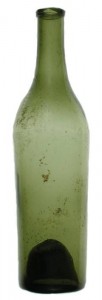 The array of bottle designs has an intriguing history.
The array of bottle designs has an intriguing history.
The modern wine bottle was a journey of man made evolution. The earliest bottles were pretty straightforward: Any vessel that could hold and serve wine, be it pottery, leather or even carved wood, was used. Though glass vessels have been used for wine since at least the Roman times, they didn’t become commonplace until the 17th century.
The shape of early wine bottles resembled an onion – a wide, round body with a short neck. Over time, as glass making techniques advanced and stronger bottles were produced , they became taller and narrower. These elongated bottles allowed vintners to store more of their product. In the 1700s, the practice of binning ( storing a bottle on its side) was created. This storage method was ideal because the cork would stay wet and swollen, ensuring a good seal.
But even with the slow transformation from short and round to tall and narrow, specific bottle shapes traditionally are commonly associated with certain regions or styles, such as the high-shouldered “Bordeaux” bottle, the sloped “Burgundy” bottle and the tall, slender “Hoch” (literally high) bottle for German wines. With the globalization of wine production, bottle shape became away to indicate what type of wine was inside. Generally you find red Bordeaux varietals such as cabernet sauvignon and merlot and whites like sauvignon blanc and semillon in the Bordeaux shape, regardless of where the grapes were grown. The same is generally true for Burgundy’s main varietals of pinot noir and chardonnay as well as the German Hoch bottle for Riesling, Gewurztraminer and Alsace wines.
THE “BORDEAUX” SHAPE
- 2010 Francis Coppola Claret Cabernet Sauvignon, California (about $14 retail)
THE “BURGUNDY” SHAPE
- 2010 Schug Pinot Noir, California (about $19 retail)
THE “HOCH” SHAPE
- 2011 Chateau Ste. Michelle Riesling, Washington (about $12 retail)